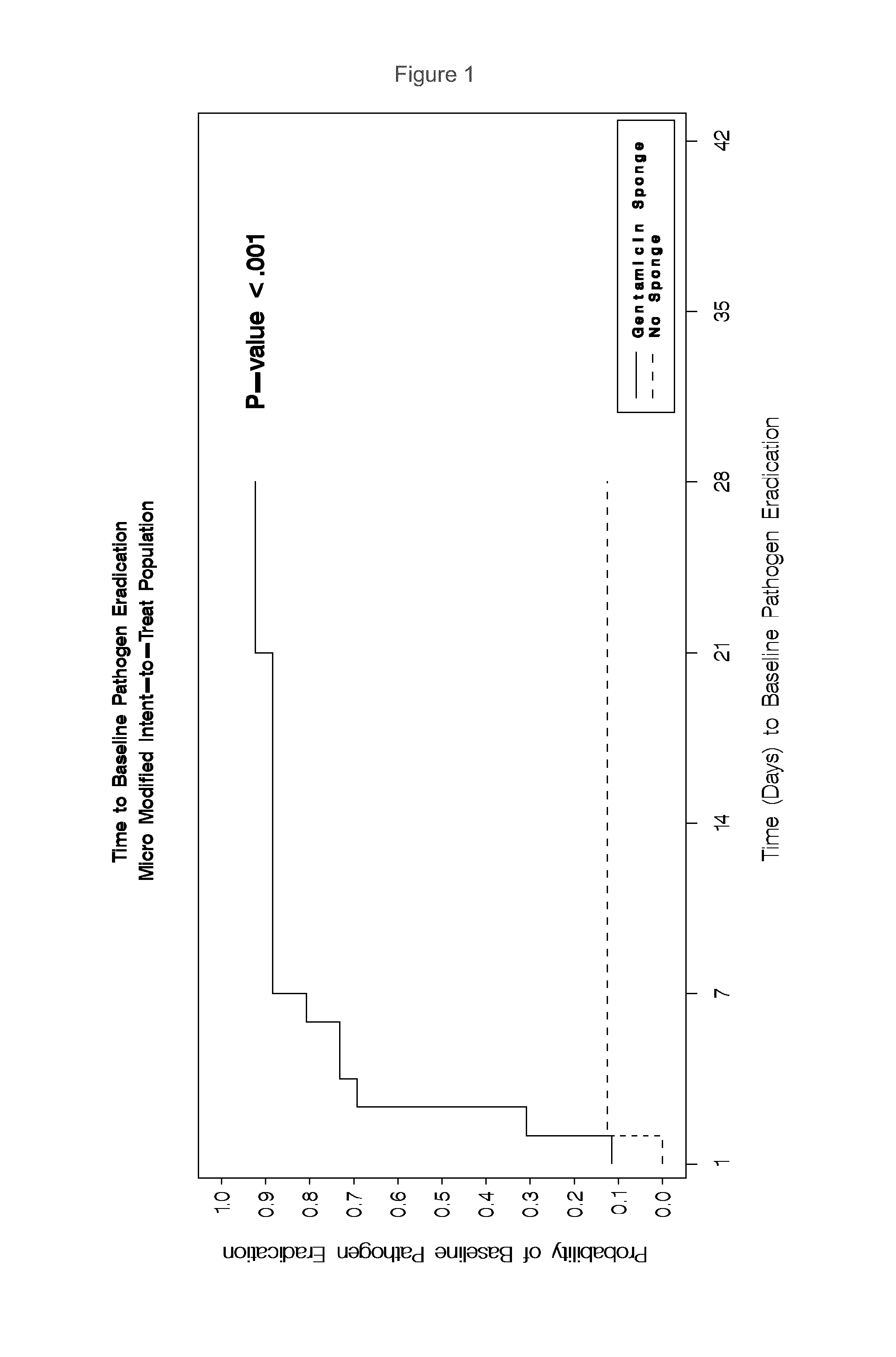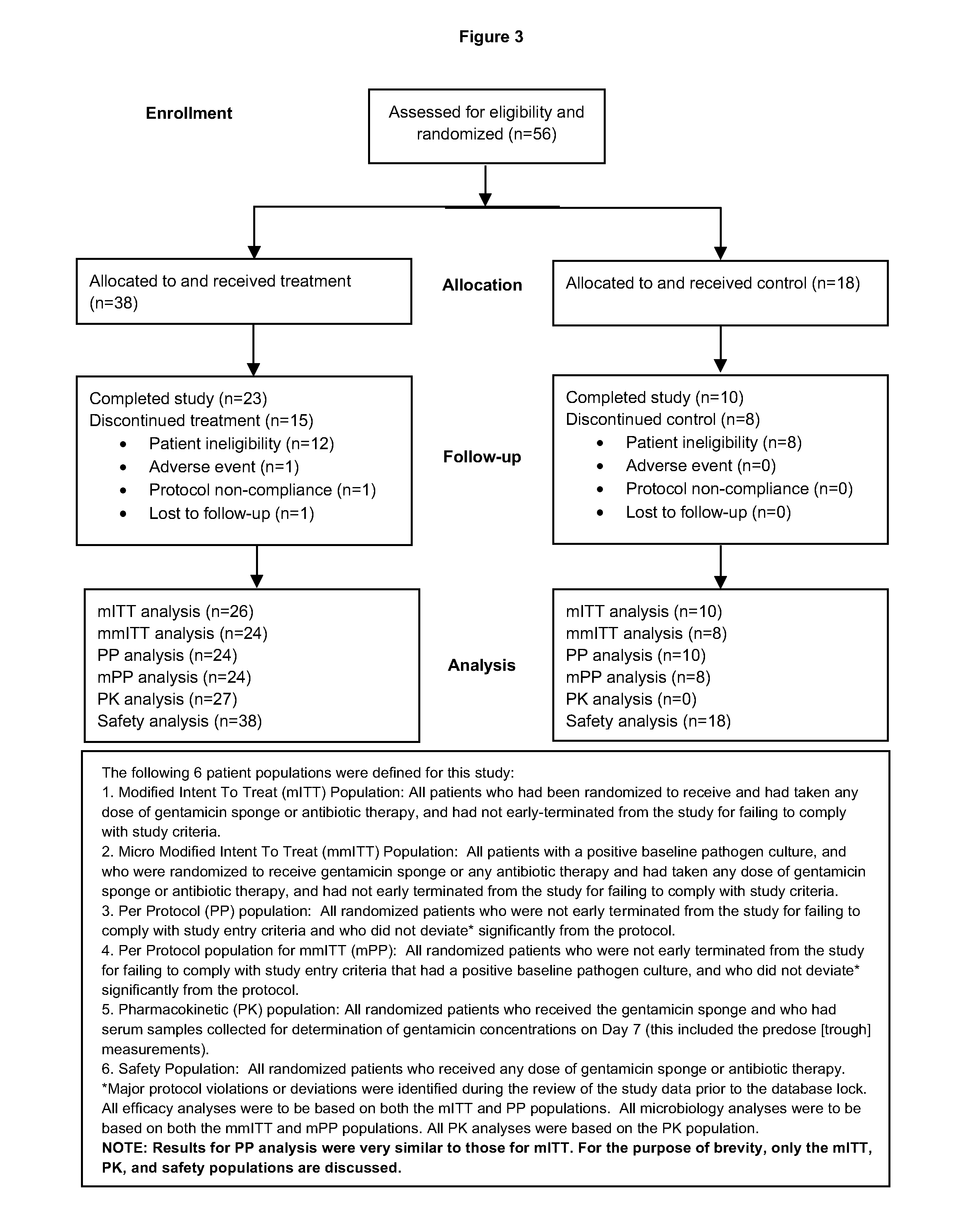Methods for treating bacterial infection
a technology for bacteria and infection, applied in the field of methods for treating bacteria, can solve the problems of diabetes patients at high risk for foot ulceration, substantial morbidity, and amputation of the lower extremities
- Summary
- Abstract
- Description
- Claims
- Application Information
AI Technical Summary
Benefits of technology
Problems solved by technology
Method used
Image
Examples
example 1
Patient Disposition
[0106]From April 2008 to the last patient's final visit in May 2009, a total of 56 patients were enrolled; 38 were randomized to the treatment group and 18 to the control group. It was decided to stop the trial before reaching the targeted sample size because enrolment in this study was more difficult than anticipated—this was largely related to the inclusion / exclusion criteria being too restrictive, particularly the requirements that patients have only a single ulcer and not have received any systemic or topical antimicrobial therapy in the preceding 2 weeks. It was also found that many randomized patients were subsequently deemed ineligible once baseline laboratory results became available.
[0107]The disposition of all enrolled patients is summarized in FIG. 3. Of 56 patients randomized, 33 (59%) completed the study while 23 were discontinued prematurely. The most common reason ( 20 / 23) for discontinuation was ineligibility because the patient failed to meet all ...
example 2
Patient Demographic Characteristics
[0109]Demographic characteristics of enrolled patients were not significantly different between the groups (See Table 1). However, assessment of baseline characteristics in the mITT population revealed an unfortunate imbalance in baseline wound severity. Baseline Lipsky Wound Scores were significantly higher in the gentamicin-sponge than the control group (median 17 vs. 12, P=0.011) and the mean baseline wound surface area was almost 4-fold larger for patients randomized to the treatment group (5.11 cm2) than the control group (1.24 cm2).
TABLE 1Patient Demographic CharacteristicsGroupTreatmentControlParameter(N = 38)(N = 18)Age (years)Mean (SD)57.9(11.47)54.7(12.80)Median (minimum,58.0(24, 80)54.5(29, 81)maximum)Gender, n (%)Male23(60.5%)15(83.3%)Female15(39.5%)3(16.7%)Racea, n (%)American-Indian or1(2.6%)0(0%)Alaskan NativeBlack or African4(10.5%)3(16.7%)AmericanNative Hawaiian1(2.6%)0(0%)or Other PacificIslanderWhite or Caucasian32(84.2%)15(83.3%...
example 3
Isolated Pathogens
[0110]Pathogens isolated from wounds at baseline are summarized in Table 2. The most commonly identified baseline pathogen for both treatment groups was Staphylococcus aureus, about equally divided between methicillin-resistant (MRSA) and methicillin-sensitive (MSSA) species. No patient was switched from oral levofloxacin to an alternative antibiotic regimen on the basis of the culture and antibiotic susceptibility results.
TABLE 2Pathogens Isolated From Diabetic Foot Wounds at BaselinemITT PopulationaSafety PopulationaTreatmentControlTreatmentControl(N = 26)(N = 10)(N = 38)(N = 18)Gram positiveβ-hemolytic5(19.2)2(20.0)7(18.4)3(16.7)Coagulase-negative7(26.9)0(0.0)10(26.3)3(16.7)Staphylococcus sppEnterococcus2(7.7)4(40.0)4(10.5)5(27.8)faecalis (VSE)Gram positive cocci0(0.0)0(0.0)1(2.6)0(0.0)(NOS)Peptostreptococcus1(3.8)1(10.0)2(5.3)1(5.6)spp.Staphylococcus7(26.9)5(50.0)9(23.7)5(27.8)aureus (MRSA)Staphylococcus6(23.1)3(30.0)10(26.3)5(27.8)aureus (MSSA)Streptococcus0(0...
PUM
| Property | Measurement | Unit |
|---|---|---|
| surface area | aaaaa | aaaaa |
| pH | aaaaa | aaaaa |
| pH | aaaaa | aaaaa |
Abstract
Description
Claims
Application Information
 Login to View More
Login to View More - R&D
- Intellectual Property
- Life Sciences
- Materials
- Tech Scout
- Unparalleled Data Quality
- Higher Quality Content
- 60% Fewer Hallucinations
Browse by: Latest US Patents, China's latest patents, Technical Efficacy Thesaurus, Application Domain, Technology Topic, Popular Technical Reports.
© 2025 PatSnap. All rights reserved.Legal|Privacy policy|Modern Slavery Act Transparency Statement|Sitemap|About US| Contact US: help@patsnap.com



